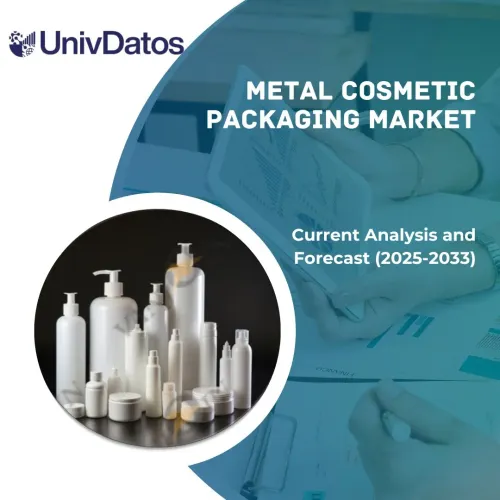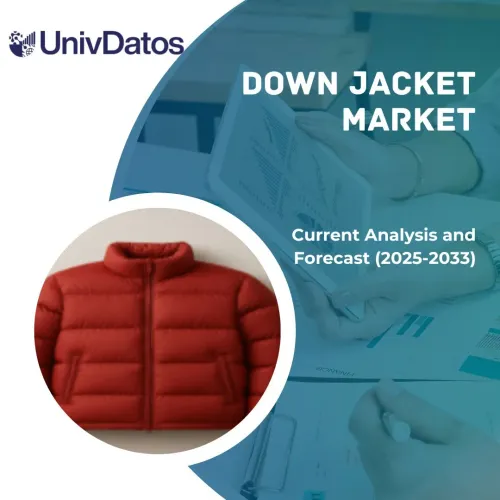Рынок напитков HoReCa: текущий анализ и прогноз (2024-2032 гг.)
Акцент на типе (алкогольные и безалкогольные напитки); конечном пользователе (отели, рестораны, кафе и другие); и регионе/стране
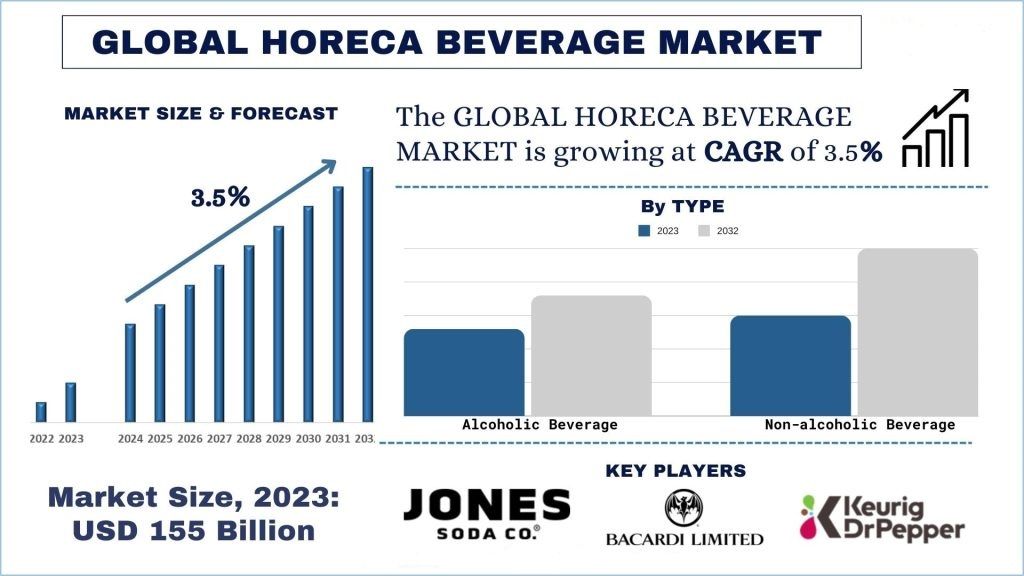
Размер и прогноз рынка напитков HORECA
Объем рынка напитков HORECA оценивался в 155 миллиардов долларов США и, как ожидается, будет расти со значительным среднегодовым темпом роста (CAGR) около 3,5% в течение прогнозируемого периода (2024-2032 гг.). Это обусловлено более высоким потреблением напитков.
Анализ рынка напитков HORECA
Рынок напитков HoReCa (отели/рестораны/кафе) относится к сектору, который поставляет напитки предприятиям индустрии гостеприимства. Сюда входят алкогольные и безалкогольные напитки, подаваемые в отелях, ресторанах, кафе, барах и других подобных заведениях. Рынок охватывает широкий ассортимент продукции, такой как безалкогольные напитки, соки, кофе, чай, пиво, вино, спиртные напитки и коктейли. Это динамичная и конкурентная отрасль, на которую влияют меняющиеся потребительские предпочтения, тенденции и правила. Увеличение количества инновационных запусков продуктов способствовало увеличению числа людей, потребляющих различные напитки, тем самым стимулируя спрос на напитки HORECA.
Согласно данным Центров по контролю и профилактике заболеваний, около 31% взрослых в нестоличных округах и 25% взрослых в столичных округах сообщили, что употребляют подслащенные сахаром напитки один или несколько раз в день.
Кроме того, в сентябре 2023 года Reliance Retail Ventures Limited (RRVL) объявила о расширении своего портфеля напитков, запустив уникальный напиток на тему крикета Campa Cricket. Также в марте 2023 года дистрибьютор спиртных напитков Ten Locks представил свой первый бренд водки, изготовленной из 100% британского гороха - Pod Pea Vodka. Интеграция цифровых платежей и маркетинговых технологий для предоставления бесконтактных услуг, таким образом, стимулирует рост рынка в течение прогнозируемого периода.
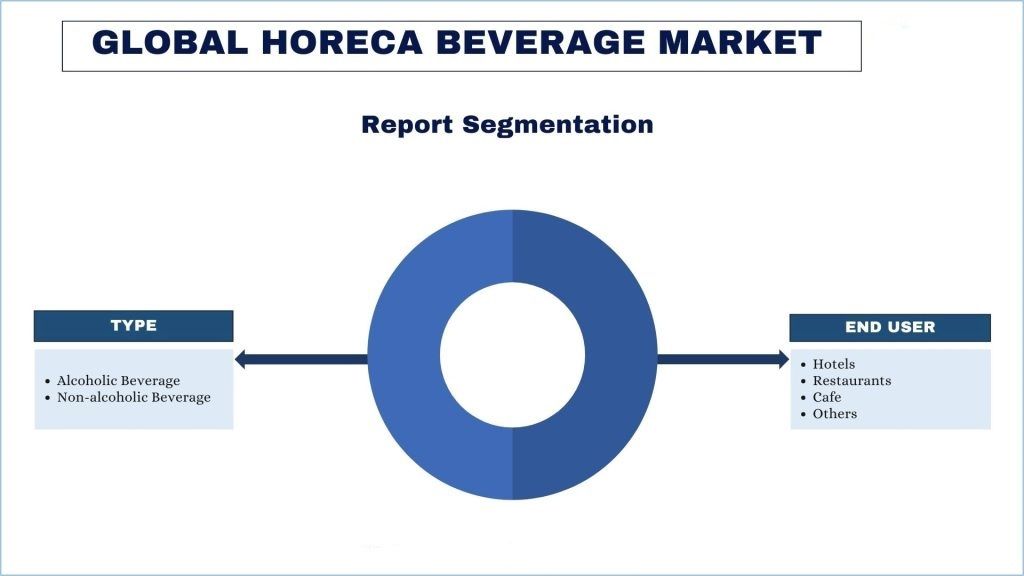
Тенденции рынка напитков HORECA
В этом разделе обсуждаются ключевые тенденции рынка, которые влияют на различные сегменты рынка напитков HORECA, как это определено нашей командой экспертов-исследователей.
Алкогольные напитки, преобразующие отрасль
Алкогольный сегмент на рынке напитков HORECA на протяжении многих лет демонстрирует устойчивый рост, обусловленный различными факторами. Потребители все чаще ищут уникальные алкогольные напитки премиум-класса, включая крафтовое пиво, ремесленные спиртные напитки и специальные коктейли, что привело к расширению предложения в секторе HORECA. Поскольку располагаемые доходы увеличились во многих частях мира, потребители более охотно тратят деньги на более дорогие алкогольные напитки, что приводит к росту доходов предприятий HORECA. Туризм играет важную роль в стимулировании продаж алкоголя в секторе HORECA, при этом путешественники часто балуются местными и региональными алкогольными напитками в рамках своего опыта питания и гостеприимства. Постоянные инновации в индустрии алкогольных напитков, включая запуск новых продуктов, вариации вкусов и форматы упаковки, способствовали повышению потребительского интереса и потребления на рынке HORECA. Потребление алкоголя часто ассоциируется с общением, праздниками и особыми случаями, что приводит к постоянному спросу в секторе HORECA на алкогольные напитки в дополнение к обедам и развлечениям. Ожидается, что в целом алкогольный сегмент на рынке напитков HORECA продолжит расти, что обусловлено меняющимися потребительскими предпочтениями, экономическими факторами и постоянными инновациями в индустрии алкогольных напитков. Например, в марте 2024 года Young Henrys выпустила новую линейку пива как раз к Пасхе. Кроме того, в апреле 2023 года датская пивоваренная компания Harboe выпустила на рынок свое сезонное пасхальное пиво в специальной серии банок, произведенных с использованием передовой технологии печати duo mix от Canpack.
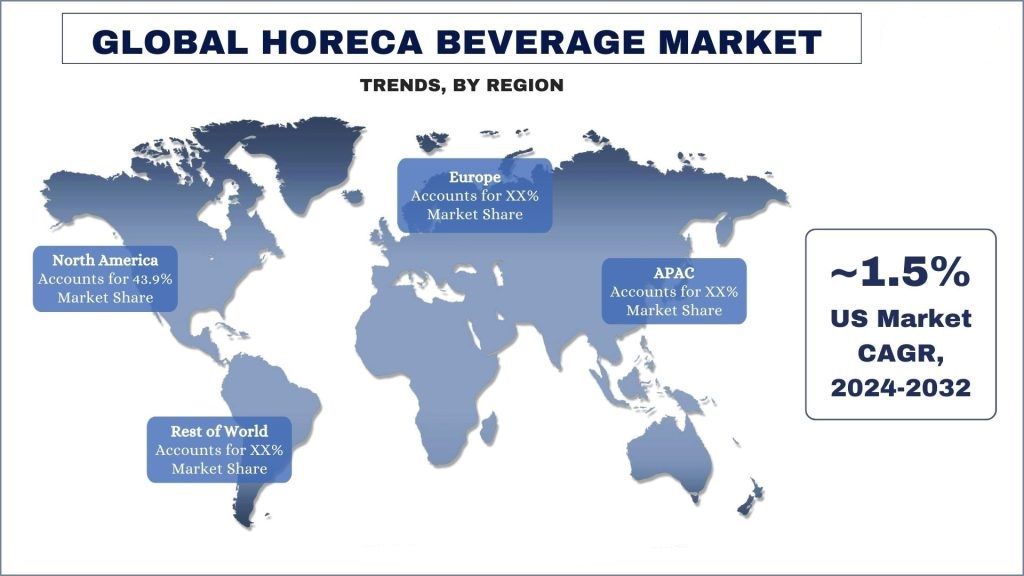
Ожидается, что Северная Америка вырастет со значительным среднегодовым темпом роста в течение прогнозируемого периода
В Северной Америке основная доля рынка приходится на США. Основными факторами, стимулирующими рост рынка в стране, являются быстрая урбанизация региона, постоянно меняющийся образ жизни, растущая тенденция к потребителям, заботящимся о своем здоровье, рост приложений для доставки еды, запуск инновационных продуктов и присутствие нескольких игроков рынка.
Согласно обзору мирового населения за 2024 год, в США один из самых высоких показателей потребления газированных напитков в мире. Граждане США выпивают примерно 154 литра на душу населения каждый год. Почти каждый пятый человек сообщает, что выпивает хотя бы один газированный напиток в день. Согласно данным Министерства здравоохранения и социальных служб США, 68% взрослых, проживающих на Северо-Востоке, 67% взрослых, проживающих на Юге, 61% взрослых, проживающих на Западе, и 59% взрослых, проживающих на Среднем Западе страны, сообщили, что употребляют подслащенные сахаром напитки один или несколько раз в день.
В апреле 2024 года американская компания Topo Chico выпустила линейку фруктовых газированных напитков с травяными экстрактами. Кроме того, в сентябре 2023 года американская компания Captain Morgan представила альтернативу Original Spiced Gold - Captain Morgan Spiced Gold 0.0%.
Обзор индустрии напитков HORECA
Рынок напитков HORECA является конкурентным, на нем присутствует несколько глобальных и международных игроков рынка. Ключевые игроки принимают различные стратегии роста для расширения своего присутствия на рынке, такие как партнерства, соглашения, сотрудничество, запуск новых продуктов, географическая экспансия, а также слияния и поглощения. К числу основных игроков, работающих на рынке, относятся Unilever; The Coca-Cola Company; Nestle; PepsiCo; Jones Soda Co.; Danone; Appalachian Brewing Company; GCMMF (Amul); Keurig Dr Pepper Inc.; и Bacardi Limited.
Новости рынка напитков HORECA
В феврале 2024 года Coca-Cola Company в сотрудничестве с Pernod Ricard объявила о дебюте Absolute Vodka & Sprite.
В сентябре 2023 года Tata Consumer Products (TCP) вышла на рынок энергетических напитков, выпустив Say Never Energy Drink.
В августе 2023 года TRDP Group запустила свой бренд водки премиум-класса в рамках группы компаний NeuWorld Spirits Pvt. Ltd.
В июле 2023 года Radico Khaitan Limited, производитель Jaisalmer Indian Craft Gin, объявила о запуске своего последнего дополнения к портфелю продуктов премиум-класса: "Happiness in a Bottle: A Happily Crafted Gin".
В марте 2023 года Coconutea выпустила органическую линейку кокосовой воды King и премиального зеленого чая в Великобритании.
Отчет об охвате рынка напитков HORECA
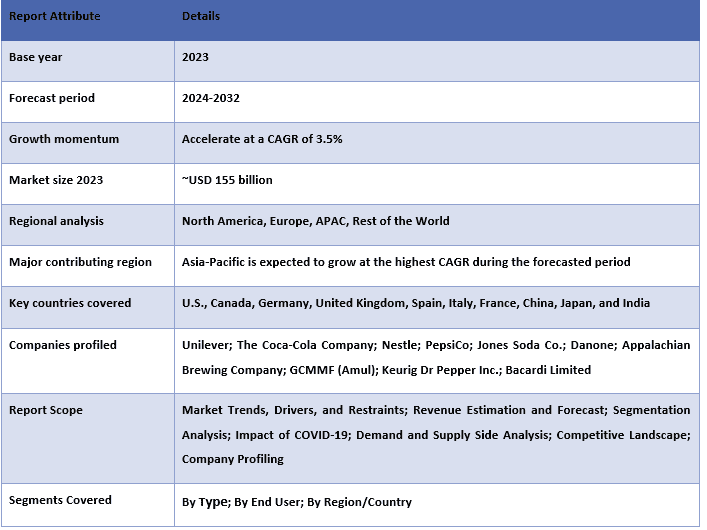
Причины купить этот отчет:
- Исследование включает анализ размеров рынка и прогнозирование, подтвержденный проверенными ключевыми экспертами отрасли.
- Отчет представляет собой краткий обзор общей производительности отрасли с первого взгляда.
- Отчет охватывает углубленный анализ видных игроков отрасли с уделением особого внимания ключевым финансовым показателям бизнеса, портфелям продуктов, стратегиям расширения и последним разработкам.
- Подробное изучение факторов, ограничений, ключевых тенденций и возможностей, преобладающих в отрасли.
- Исследование всесторонне охватывает рынок по различным сегментам.
- Глубокий анализ отрасли на региональном уровне.
Варианты настройки:
Глобальный рынок напитков HORECA может быть дополнительно настроен в соответствии с требованиями или любым другим сегментом рынка. Кроме того, UMI понимает, что у вас могут быть свои собственные бизнес-потребности, поэтому не стесняйтесь обращаться к нам, чтобы получить отчет, который полностью соответствует вашим требованиям.
Содержание
Методология исследования анализа рынка напитков HORECA (2024-2032 гг.)
Анализ исторического рынка, оценка текущего рынка и прогнозирование будущего рынка глобального рынка напитков HORECA были тремя основными этапами, предпринятыми для создания и анализа внедрения напитков HORECA в основных регионах мира. Было проведено тщательное вторичное исследование для сбора исторических данных о рынке и оценки текущего размера рынка. Во-вторых, для подтверждения этих выводов было принято во внимание множество результатов и предположений. Кроме того, были проведены исчерпывающие первичные интервью с отраслевыми экспертами по всей цепочке создания стоимости глобального рынка напитков HORECA. После предположений и подтверждения рыночных показателей посредством первичных интервью мы использовали восходящий/нисходящий подход к прогнозированию полного размера рынка. После этого были приняты методы декомпозиции рынка и триангуляции данных для оценки и анализа размера рынка сегментов и подсегментов, к которым относится отрасль. Подробная методология описана ниже:
Анализ исторического размера рынка
Шаг 1: Углубленное изучение вторичных источников:
Было проведено подробное вторичное исследование для получения данных об историческом размере рынка напитков HORECA из внутренних источников компании, таких как годовые отчеты и финансовая отчетность, презентации о деятельности, пресс-релизы и т. д., и внешних источников, включая журналы, новости и статьи, правительственные публикации, публикации конкурентов, отраслевые отчеты, сторонние базы данных и другие надежные публикации.
Шаг 2: Сегментация рынка:
После получения данных об историческом размере рынка напитков HORECA мы провели подробный вторичный анализ для сбора исторических данных о рынке и доле различных сегментов и подсегментов для основных регионов. Основные сегменты, включенные в отчет, включают тип, конечного пользователя и регионы. Был проведен дальнейший анализ на уровне страны для оценки общего внедрения моделей тестирования в этом регионе.
Шаг 3: Факторный анализ:
После получения данных об историческом размере рынка различных сегментов и подсегментов мы провели подробный факторный анализ для оценки текущего размера рынка напитков HORECA. Кроме того, мы провели факторный анализ с использованием зависимых и независимых переменных, таких как тип, конечный пользователь и регионы рынка напитков HORECA. Был проведен тщательный анализ сценариев спроса и предложения с учетом ведущих партнерств, слияний и поглощений, расширения бизнеса и запуска продуктов в секторе рынка напитков HORECA по всему миру.
Оценка текущего размера рынка и прогноз
Определение текущего размера рынка: На основе практически применимых данных, полученных в результате вышеуказанных 3 этапов, мы определили текущий размер рынка, ключевых игроков на глобальном рынке напитков HORECA и доли рынка сегментов. Все необходимые процентные доли и разбивки рынка были определены с использованием вышеупомянутого вторичного подхода и были проверены посредством первичных интервью.
Оценка и прогнозирование: Для оценки и прогнозирования рынка различным факторам, включая движущие силы и тенденции, ограничения и возможности, доступные для заинтересованных сторон, были присвоены веса. После анализа этих факторов были применены соответствующие методы прогнозирования, то есть восходящий/нисходящий подход, для получения прогноза рынка на 2030 год для различных сегментов и подсегментов на основных рынках по всему миру. Методология исследования, принятая для оценки размера рынка, включает в себя:
- Размер рынка отрасли с точки зрения выручки (USD) и темпы внедрения рынка напитков HORECA на основных рынках внутри страны
- Все процентные доли, разделения и разбивки сегментов и подсегментов рынка
- Ключевые игроки на глобальном рынке напитков HORECA с точки зрения предлагаемых продуктов. Кроме того, стратегии роста, принятые этими игроками для конкуренции на быстрорастущем рынке
Подтверждение размера и доли рынка
Первичное исследование: Были проведены углубленные интервью с ключевыми лидерами общественного мнения (KOL), включая руководителей высшего звена (CXO/вице-президенты, руководители отдела продаж, руководители отдела маркетинга, руководители операционного отдела, региональные руководители, руководители стран и т. д.) в основных регионах. Затем результаты первичного исследования были обобщены и проведен статистический анализ для доказательства заявленной гипотезы. Входные данные первичного исследования были объединены с вторичными данными, что позволило превратить информацию в практически применимые выводы.
Распределение основных участников по различным регионам
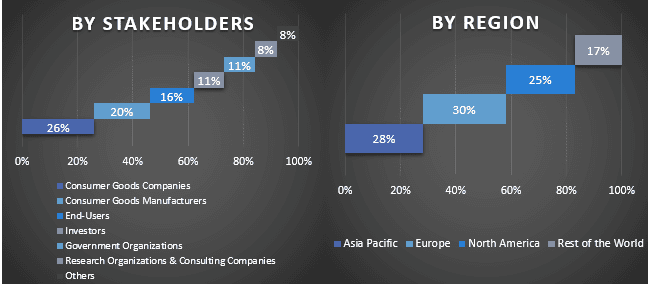
Инжиниринг рынка
Метод триангуляции данных был использован для завершения общей оценки рынка и получения точных статистических данных для каждого сегмента и подсегмента глобального рынка напитков HORECA. Данные были разделены на несколько сегментов и подсегментов после изучения различных параметров и тенденций в областях типа, конечного пользователя и регионов на глобальном рынке напитков HORECA.
Основная цель исследования глобального рынка напитков HORECA
В исследовании были точно определены текущие и будущие рыночные тенденции глобального рынка напитков HORECA. Инвесторы могут получить стратегические сведения, чтобы основывать свое решение для инвестиций на качественном и количественном анализе, выполненном в исследовании. Текущие и будущие рыночные тенденции определили общую привлекательность рынка на региональном уровне, предоставляя промышленному участнику платформу для использования неиспользованного рынка, чтобы извлечь выгоду из преимущества первопроходца. Другие количественные цели исследований включают:
- Анализ текущего и прогнозируемого размера рынка напитков HORECA в стоимостном выражении (USD). Также анализ текущего и прогнозируемого размера рынка различных сегментов и подсегментов.
- Сегменты исследования включают области типа, конечного пользователя и регионы.
- Определение и анализ нормативно-правовой базы для HORECA beverage
- Анализ цепочки создания стоимости, связанной с присутствием различных посредников, а также анализ поведения клиентов и конкурентов в отрасли.
- Анализ текущего и прогнозируемого размера рынка напитков HORECA для основного региона.
- Основные страны регионов, изученные в отчете, включают Азиатско-Тихоокеанский регион, Европу, Северную Америку и остальной мир.
- Профили компаний рынка напитков HORECA и стратегии роста, принятые участниками рынка для поддержания конкурентоспособности на быстрорастущем рынке.
- Углубленный анализ отрасли на региональном уровне
Часто задаваемые вопросы Часто задаваемые вопросы
В1: Каков текущий размер рынка напитков HORECA и его потенциал роста?
Q2: Какие факторы являются основными драйверами роста рынка напитков HORECA?
Q3: Какой сегмент имеет наибольшую долю рынка напитков HORECA по типу?
Q4: Каковы новые технологии и тенденции на рынке напитков HORECA?
В5: Какой регион будет доминировать на рынке напитков HORECA?
Связанные Отчеты
Клиенты, купившие этот товар, также купили





